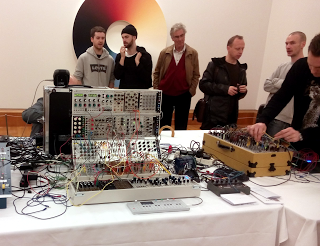Today, I went to the Loud Tate event. My friend Antonio Roberts was presenting some work. Also, there were workshops on glitch and modular synthesis.
Antonio’s piece was a projection of ever changing glitch, which my mobile phone camera failed to adequately capture. It was being shown on the underside of an arch in a round stairwell. Tate Britain is really full of art, so it must be hard to accomodate one day installations.
The synthesisers were set up in the middle of a gallery. Three guys with cool modular systems were buried in their wires, twisting knobs and making beats. I’m not totally sure how educational it was, but I did get to look over their shoulders. Modules have changed a lot since I got my MOTM system in 1998-2000. There are a lot of cool new ideas and, I suspect, new ways of labelling the old ideas, which make it slightly confusing for a fogey like myself. I commented to somebody that synthesisers had changed a lot in the last 14 years and, anyway, it turns out this event was actually meant for people under 25.
I suspect that at least one of the guys with the synths was playing with the analog modular group that I had tried to take my dad to see, the night that he developed his heart problems. I kind of wanted to ask if they were the same guys, but I thought the conversation might get awkward…
I do have one new module that I’ve yet to fully explore, and I’m pondering adding a few others to get caught up with these modern times. I’m looking forward to using my new module in a commission. It models orbital dynamics of planets in some way. I’m hoping it can be made to undulate, which is a customer request I’ve just gotten.
The visual glitchers were also having a meeting, so I went there to see Antonio. Unfortunately, I missed their presentations, but I did catch Antonio giving a quick tutorial in graphic glitching. He saved an image as a bitmap and then opened it in Audacity as a u-law file. He added some phasing and echo effects and then re-saved it as a bmp. It did interesting things to the image. What I want to experiment with is going the other way. This would likely entail:
- Convert an audio file to ulaw format.
- Save that file as a .bmp
- Open the .bmp in an image editor, such as GIMP
- Apply effects to the image, such as reversing it, colour correction, try drawing – I need to play around on this step to see what would happen
- Open the bmp in audacity. If it sounds good, convert it back to a WAV or AIFF.
I’m going to try this out when I get a moment. Right now all my commissions are all analogue, so this would be a good experiment for a digital commission, when one of those arrives. I will report back on how it worked in practice.
Tomorrow is an ‘informal meet and greet’ in London for analogue synth users. I’m going to bring my new module – and a screw driver. The mounting rails on it are super fiddly and I cannot get the thing to screw in without cross-threading it. It’s become too frustrating, so I put it aside and hopefully somebody with a steadier hand and more patience can help out.
Your commissions are fun to research and fun to make. They make great gifts. Order now and delivery is guaranteed in time for Christmas or Hanukkah. Act now to get the sale price of just £5 for one piece – there are only two left at that price point!
Do you love noise music? Do you have fashion? Drop me an email if you’d like your image to be in forthcoming posts about noise and fashion



